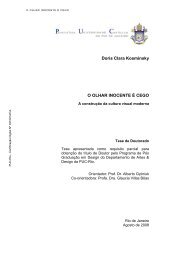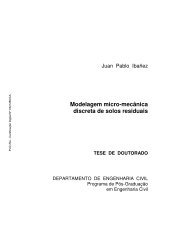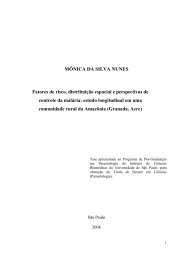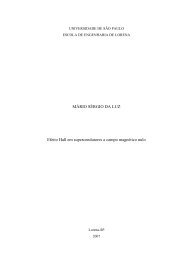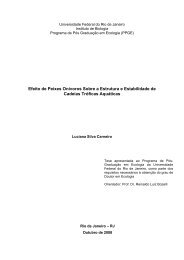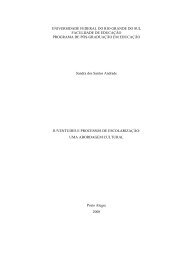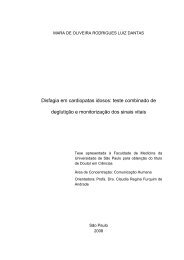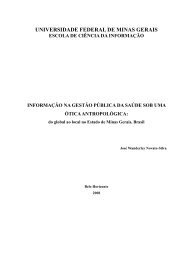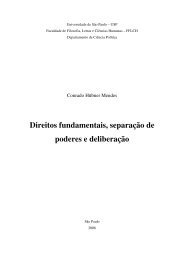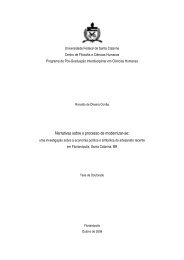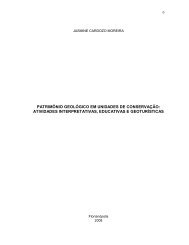You also want an ePaper? Increase the reach of your titles
YUMPU automatically turns print PDFs into web optimized ePapers that Google loves.
R. Sousa Car<strong>do</strong>so et al.tissue-specific antigens are expressed in the thymus andcontribute to the selection of the T-cell repertoire. Thesetissue-specific antigens are expressed as a normal physiologicalproperty of thymic epithelial cells (TECs). 6 Thisphenomenon was termed promiscuous <strong>gene</strong> expression(PGE), which includes self antigens that represent most ofthe parenchymal organs. 7–14 Evidence of PGE in the thymusis causing a reversal in our understanding of centraltolerance, allowing for an unortho<strong>do</strong>x conception of thepossible mechanism of self–non-self discrimination. 15,16The initial evidence for promiscuously expressed <strong>gene</strong>swas biased towards antigens involved in autoimmunereactions, such as insulin, acetylcholine receptor or myelinbasic protein. Today it is recognized that rather thanbeing selective, the set of expressed <strong>gene</strong>s is as broad aspossible, estimated to include up to 5–10% of all currentlyknown mouse <strong>gene</strong>s. 9 Thus, the main implicationof this hetero<strong>gene</strong>ous <strong>gene</strong> expression in the thymus isassociated with maintenance of the immunological homeostasisin the body, controlling pathogenic autoimmunereactions.Studies on thymus <strong>gene</strong> expression in the broadestaspect, including PGE, are normally designed to be performedimmediately using samples collected by surgery,which must reflect the short-term in vivo situation.Nevertheless, fetal thymus organ culture (FTOC), introducedby DeLuca’s group, 17 which is based on the use ofearly fetal thymus tissue, preserves the original architectureof the thymus, with its cellularity formed of stromalTECs and homo<strong>gene</strong>ous thymocyte population <strong>do</strong>ublenegativecells. This is a singular, powerful culture modelsystem reproducing intrathymic T-cell developmentin vivo, making it easier to study the candidate <strong>gene</strong>simplicated in normal thymus development. Using thecDNA microarray method, our group recently showedthe modulation of <strong>gene</strong> expression in murine FTOCs atthe transcriptome level and revealed an overlap between<strong>gene</strong>s associated with T-cell receptor V(D)J recombinationand DNA repair. We showed that the association ofFTOC and cDNA microarray technology allows sufficientaccuracy to uncover the participation of essential <strong>gene</strong>simplicated in thymus development. 18In the present study, cDNA microarrays were employedto observe the onset of PGE during the in vitro developmentof murine thymus in FTOCs. Comparing the timeof thymus gestation as a result of fetal age and cultureduration, it was possible to discover the onset of <strong>gene</strong>induction, representing 57 different parenchymal andseven lymphoid organs. Some coded proteins are consideredto be tissue-specific antigens, thus indicating thatFTOCs reproduce promiscuous <strong>gene</strong> expression.The FTOC transcriptome profiling was assessed using aset of six nylon cDNA microarrays containing a total of9216 IMAGE thymus sequences. PGE was identified on thebasis of <strong>gene</strong> expression data for different parenchymalorgans. To our knowledge, these findings represent thefirst demonstration of the temporal beginning of PGE inmurine FTOC. Moreover, the importance of this event isassociated with the fact that this model system could be auseful tool for testing cytokines, RNA interference orother compounds that directly control <strong>gene</strong> expression inthe thymus, as possible modulators of PGE.Material and methodsFTOCs and total RNA preparationBALB/c mice were bred in an isolator with 045-lm poresizeair filtered in our own breeding facility. To obtaintimed pregnancies, the mice were mated and the daywhen the vaginal plug was observed at 7:00 hr was consideredto be day zero of gestation post-coitum (p.c.).The pregnant mice were killed by ether inhalation andthe fetuses were collected via surgery of the uterus. Thep.c. age of the fetuses was confirmed by the morphologicalcharacteristics of each developmental phase. 18,19 Thethymi were removed from the fetuses under a stereomicroscopeand cultured according to the organ culturetechnique previously described. 17Briefly, the organs were dissected and cleaned from theadjacent tissue and placed on the surface of Millipore filters(045 lm pore size) pre-embedded with culture medium.These filters were supported on plastic grids in 2 mlDulbecco’s modified Eagle’s medium/HAM F-10 culturemedium (Gibco, Gaithersburg, MD, USA) supplementedwith 20% heat inactivated fetal bovine serum (Biobrás,Montes Claros, MG, Brazil) in 24-well tissue cultureplates. The medium was also supplemented with 100 lg/mlstreptomycin, 250 U/ml penicillin, 10 lg/ml gentamicin,1mM sodium pyruvate, 20 lM 2-mercaptoethanol and34 g/l sodium bicarbonate. The incubation time of theorgan culture varied from 2 to 5 days at 37° in a 5% CO 2incubator.Thymi were dissected from fetuses obtained at 13, 14and 15 days of gestation and cultured for 2 days, so mimicking15, 16 and 17 days p.c. of in vivo development,respectively. Thymi from 15-day p.c. fetuses were alsocultured for 5 days, mimicking the 20th day of in vivodevelopment, and in this case, the culture medium waschanged on the third day of incubation.To evaluate the viability of FTOCs, three ran<strong>do</strong>mlyselected thymi from each group were used for the singlecell suspension preparations, which were separatelystained with acridine orange (100 lg/ml) or with ethidiumbromide (100 lg/ml) and analysed on an AxiophotII fluorescence microscope (Carl Zeiss, Oberkochen, Germany)to evaluate the frequency of apoptosis and necrosis,respectively. Total RNA samples were prepared fromFTOCs using Trizol Ò reagent according to the manufacturer’sinstructions (Invitrogen, Carlsbad, CA, USA).370 Ó 2006 Blackwell Publishing Ltd, Immunology, 119, 369–375



